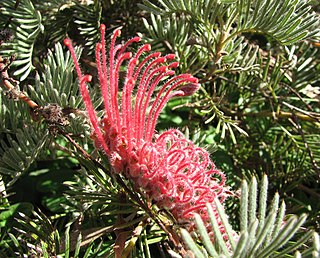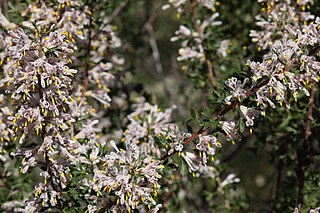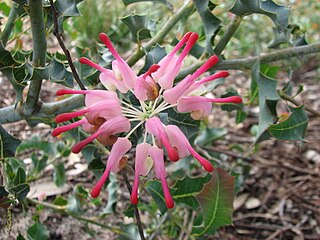
Banksia nana, commonly known as dwarf dryandra, is a species of shrub that is endemic to a small area in the south-west of Western Australia. It has underground stems, pinnatipartite leaves with sharply-pointed lobes, pale green or yellow flowers and broadly egg-shaped follicles.

Banksia shuttleworthiana, commonly known as bearded dryandra, is a species of low, spreading shrub that is endemic to Western Australia. It has thin, woolly-hairy stems, linear pinnatisect leaves, creamy brown to purplish flowers in heads of about forty and later, only a few egg-shaped follicles in each head.
Banksia tortifolia is a small, spreading, prostrate shrub that is endemic to the southwest of Western Australia. It has short underground stems, pinnatipartite leaves with sharply-pointed, linear lobes on each side, greenish-cream, yellow and pink flowers in heads of about eighty, and glabrous, egg-shaped follicles.

Grevillea thyrsoides is a species of flowering plant in the family Proteaceae, and is endemic to the southwest of Western Australia. It is a small, spreading or low-lying shrub, with pinnatisect to comb-like leaves, the end lobes linear, and clusters of hairy pinkish-red flowers.

Isopogon adenanthoides, commonly known as the spider coneflower, is a plant in the family Proteaceae and is endemic to the southwest of Western Australia. It is an erect shrub with sharply-pointed, trifid leaves and spherical heads of pink flowers.

Grevillea argyrophylla, the silvery-leaved grevillea, is a species of flowering plant in the family Proteaceae and is endemic to the south-west of Western Australia. It is an erect, sometimes low-lying shrub with egg-shaped leaves with the narrower end towards the base, and white flowers, sometimes tinged with pink.

Petrophile biloba, commonly known as granite petrophile, is a species of flowering plant in the family Proteaceae and is endemic to the south-west of Western Australia. It is a shrub with pinnately-divided leaves with sharply-pointed tips, and oval heads of hairy, mostly grey to pink flowers.

Grevillea acrobotrya is a species of flowering plant in the family Proteaceae and is endemic to the southwest of Western Australia. It is a prickly, spreading to erect shrub with egg-shaped to trowel-shaped leaves with sharply-tipped lobes, and white to cream-coloured flowers with smaller leaves at the base.
Persoonia rufiflora is a species of flowering plant in the family Proteaceae and is endemic to the south-west of Western Australia. It is an erect, sometimes spreading shrub with hairy young branchlets, lance-shaped to linear leaves, and hairy, greenish yellow flowers arranged singly or in pairs.

Grevillea insignis, commonly known as wax grevillea, is a species of flowering plant in the family Proteaceae and is endemic to the south-west of Western Australia. It is an erect, bushy shrub with more or less oblong leaves with seven to seventeen sharply-pointed, triangular teeth, and more or less spherical or cylindrical clusters of cream-coloured flowers ageing to pink.

Persoonia comata is a species of flowering plant in the family Proteaceae and is endemic to the south-west of Western Australia. It is an erect, sometimes spreading to low-lying shrub with mostly smooth bark, spatula-shaped to lance-shaped leaves with the narrower end towards the base and yellow flowers usually in groups of ten to fifty along a rachis up to 250 mm (9.8 in) long.

Grevillea erinacea is a species of flowering plant in the family Proteaceae and is endemic to the south-west of Western Australia. It is a spreading shrub with deeply-divided leaves with three to five linear lobes, rotated through 90°, and cream-coloured flowers with a white style.

Petrophile biternata is a species of flowering plant in the family Proteaceae and is endemic to the south-west of Western Australia. It is a shrub with biternate or pinnate, sharply-pointed leaves, and oval or spherical heads of glabrous, sticky, yellow flowers.
Petrophile chrysantha is a species of flowering plant in the family Proteaceae and is endemic to the south-west of Western Australia. It is a small shrub with crowded, sharply-pointed, pinnately-divided leaves, and oval heads of hairy, cream-coloured to dark yellow flowers.
Petrophile circinata is a species of flowering plant in the family Proteaceae and is endemic to the south-west of Western Australia. It is a low, spreading shrub with pinnately-divided, sharply-pointed leaves, and more or less spherical heads of hairy, white, yellow or cream-coloured flowers.

Petrophile conifera is a species of flowering plant in the family Proteaceae and is endemic to the south-west of Western Australia. It is a bushy, much-branched shrub with pinnate, sharply-pointed leaves, and oval heads of hairy, cream-coloured to yellowish white flowers.

Petrophile drummondii is a species of flowering plant in the family Proteaceae and is endemic to southwestern Western Australia. It is a shrub with rigid, pinnate leaves with needle-shaped, sharply-pointed pinnae, and spherical heads of hairy, fragrant, yellow flowers.

Petrophile plumosa is a species of flowering plant in the family Proteaceae and is endemic to southwestern Western Australia. It is a shrub with rigid, sharply-pointed, sometimes lobed leaves, and more or less spherical heads of hairy, pale yellow flowers.

Isopogon tridens, commonly known as the three-toothed coneflower, is a species of flowering plant in the family Proteaceae and is endemic to the southwest of Western Australia. It is a shrub with wedge-shaped leaves with two or three sharply-pointed teeth, and flattened-spherical heads of glabrous creamy white, sometimes purple flowers.

Isopogon inconspicuus is a plant in the family Proteaceae and is endemic to the southwest of Western Australia. It is a small shrub with pinnate leaves with cylindrical leaflets, and pink to purple flowers covered with grey hairs.

















